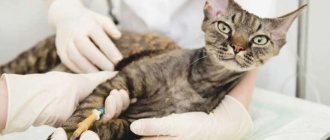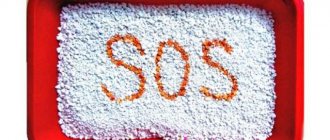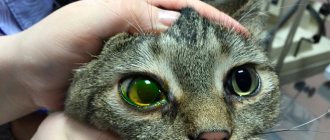The reasons why pododermatitis develops in cats are varied, so in order to cure this disease, you must first find and eliminate the original source of the problem. If your cat has sores on the paw pads that bleed and do not go away for a long time, you should not hesitate to visit the veterinarian, as untimely treatment leads to serious consequences.
Causes and risk factors
Until now, the exact root causes of this disease of cat paws have not been clarified. It is assumed that the trigger for the development of pathology may be a decrease in immunity and activation of opportunistic microflora. This includes various types of bacteria and fungi. While the immune system copes with the load, microorganisms are in a latent state, but at the slightest failure they are activated, causing various diseases, including pododermatitis.
Another suspected reason is negative environmental factors. Diseases of the paws and fingers often appear on cold days when there is severe frost outside. In such conditions, the paw pads freeze, peel, and then crack. Often contact with chemicals used to combat snow and ice causes wounds on unprotected pads. The sore can also occur due to the introduction of a strong allergen into the cat’s body. A.N. Gehrke, Ph.D., veterinary dermatologist, suggests that feline plasmacytic pododermatitis may begin to progress against the background of autoimmune disorders (vetpharma.org/articles/66/4787/). However, such a pathology is difficult to diagnose, so often the original source of the disease becomes unclear.
The risk group for developing this pathological process includes all breeds of cats, regardless of age and environmental conditions.
Pododermatitis
Pododermatitis or inflammation of the soft tissues of the paws is the most common disease in cats and dogs. During pododermatitis, the animal has difficulty taking normal steps, and any movement leads to severe discomfort and pain. Because of this, cats and kittens develop nervousness and aggressive behavior.
© shutterstock
It is difficult to identify this diagnosis in the first stages; they are impossible for the average person to notice. Therefore, the disease starts, and the consequences become irreversible.
Causes of the disease:
- influence of pathogenic bacteria. When a cat has injured its paw, the variation in bacteria entering the body increases significantly. Incorrect disinfecting manipulations cause fungal manifestations in the tissues of the paws. It is difficult to detect and even more difficult to treat. Most often, the result is a chronic fungal disease.
- hypothermia. During the cold period, there is a risk of severe hypothermia, and therefore it is not recommended to let cats go for a walk during this period. The streets are filled with chemicals, and they can irritate the delicate tissue of the paws, which can cause necrosis in felines. Because of this, the pads are completely destroyed, and as a result - lameness.
- exposure to allergens. Allergens can cause dermatitis; indoor cats are more susceptible to this. A weakened animal's immune system may not cope well with this disease.
- consequences of autoimmune diseases. Most often, plasmacytic pododermatitis appears after autoimmune diseases. Due to the late detection and treatment of the disease, it is necessary to give the cat special medications throughout its life to keep the disease under control.
Symptoms and diagnosis of pododermatitis
Every second observation will help to identify any disease in the early stages, and contacting a specialist in the early stages will help to avoid negative consequences and quickly cure feline diseases in a cat.
In the initial stages of paw pad problems, there are various symptoms:
- the cat spends a lot of time on paw hygiene
- the pads are very soft
- From time to time blood is visible on the surface of the pads
Ignoring any of the signs can contribute to the development of severe necrosis, which carries with it a high likelihood of sepsis. In this case, veterinarians cannot guarantee a high survival rate for the cat, and most methods of treating the disease are ineffective.
© shutterstock
Manifestation of the disease
As the disease progresses, sores may appear on the pads of the feet.
Normally, a healthy cat has pads on the front and hind paws (including the carpal paws), pink, smooth, and moderately dry. With pododermatitis, in the initial stages of development, the cat's paw pads increase slightly in size, but discomfort is not yet a concern, which is why it is so difficult to diagnose the pathology at stage 1. Further, the affected areas soften, their color becomes unnaturally bluish. It is difficult to notice the pathology if the seals' pads are black, but if you look closely, you will be able to notice peeling and hair falling out in the affected areas. In advanced stages, bacterial inflammation occurs; in places where the pads are cracked, red bleeding wounds appear that do not heal. The paws are hot to the touch and very dry. If the pathology is not treated, necrosis develops, which often leads to the death of the pet.
Cat paw print
The print of a cat's paw is round, without traces of claws, because representatives of the family walk with retracted claws that do not touch the ground. The paws leave a mark of four toes and, no matter the hind leg or the front leg, and the metacarpal soft. The two front fingers are located in close proximity to each other, while the side ones are slightly distant from the central ones. When landing a jump, a profitable fingerprint may be left behind. When pursuing prey, the tracks of the four legs come closer together.
Diagnostic methods
If your cat's pads are cracking, and the wound is bleeding and does not heal for a long time, you should not delay a visit to the veterinarian. After the initial examination, a sample is taken from the affected area for microscopic, cytological and histological examination. The sensitivity of the identified pathogen to antibiotics is also determined.
It is important that the doctor distinguishes the animal’s disease from pemphigus foliaceus in time.
There are other dangerous diseases in which the paw pads peel off and become an unnatural color. Therefore, differential diagnosis must be carried out, which will help exclude such pathologies:
- eosinophilic granuloma;
- neoplasia;
- pemphigus foliaceus;
- injury.
Pads to survive
Our beloved cats tiptoe through life. And the point is not in the beauty and grace of such a gait - people with mustaches hardly think about this. Simply walking and running on your toes increases the chances of a successful hunt - thus the swing becomes longer and the speed is higher.
In addition, the pads work as sound absorbers - it’s not without reason that they say: she walked in quietly, like a cat. The pads soften both the sound of a jump and the sound of a step, which is especially important when hunting. A cat that sneaks around on tiptoe is very difficult for potential prey to notice!
The small paw pads contain a large number of nerve endings that help assess temperature and surface texture, as well as sense unevenness, which helps maintain balance.
Also, these nerve endings very sensitively pick up the slightest vibration - this is what is associated with the ability of cats, and many other animals, to “predict” earthquakes. There is nothing mystical here; cats begin to show anxiety several hours before the first tremors, as they sense the slight vibration of the soil that precedes it.
How to treat?
Drug treatment
If the pads on a cat’s paws are dry, severely cracked, and due to bleeding sores the animal cannot move normally, complex drug treatment is prescribed. The following groups of drugs are used:
- Systemic glucocorticosteroids. Reduce the manifestation of the disease, eliminate inflammation. The dosage is determined by the doctor taking into account the weight and age of the cat. The following drugs are used: Prednisolone;
- "Methylprednisolone."
- "Doxycycline";
To increase immunity, immunostimulating agents, vitamins, mineral complexes, and dietary supplements are prescribed.
Surgical
Sometimes the animal's recovery depends on the operation.
Sometimes drug treatment does not bring results. The pads remain modified and deformed. As a result, the animal cannot move normally, as the enlarged tissues interfere. In this case, the doctor will advise removing the affected area. After surgery, pododermatitis completely disappears without the use of medications.
Ingrown claws in cats
Cats need to scratch non-stop to keep their claws sharp and clean. When members of the cat family are unable to sharpen their claws, health problems occur. For pets, you need to install a scratching post at home so that cats can have the opportunity to stretch their claws without any problems.
Ingrowth occurs more often in cats that are not very active. Therefore, the owner needs to monitor the condition of the animal’s claws and maintain them in a normal form - trim off the excess so that the paw pads do not grow into the soft tissues. Because of this, the paw will hurt, and inflammation and even a purulent process may begin in the claw area due to the accumulation of dirt in this place. In this case, the veterinarian should prescribe medication for the cat.
If the problem is not treated, the inflammatory process will cause discomfort and pain to the animal, prevent the cat from moving normally, and the animal will limp. It is recommended to trim ingrown claws at home with special pliers, or use the services of a specialist.
Prevention
To prevent the development of pododermatitis, it is important to constantly examine the animal’s paws, even if the cat is black, the disease will be visible by peeling and unnatural dryness. As a preventive measure, it is recommended to wash the cat’s paws with disinfectants, not let him go outside during the cold season, and increase the body’s protective functions. If there are characteristic symptoms, do not self-medicate, but urgently take your pet to the hospital. If diagnosis and treatment are timely, complications can be avoided.
Thermoregulation pads
You won't find a cat with sweaty armpits anywhere! And not because cats don’t sweat—every living creature needs a thermoregulation mechanism. They just sweat through their paw pads. Those who have visited the veterinarian with their pet have probably noticed small paw prints on the examination table.
This means that the tailed friend has experienced not the most pleasant moments in his life. However, cats do not only sweat during times of stress. On hot days, this “cooling system” helps avoid overheating.
Burn or frostbite
Sudden temperature changes have an extremely negative effect on the condition of the skin. In cold weather, cats try to be closer to sources of heat, and can accidentally burn their paw pads on a stove or heater that has just been turned off.
You might be interested in: A cat was bitten by a wasp: how and how to help your pet?
Frostbite threatens a pet that has free access to the street. Of course, it rarely comes to tissue necrosis, but slight peeling is a common occurrence on the paws of a “walking” cat.











